Besides the Blackbird and the European Song Thrush, the White’s thrush (Zoothera aurea) is the only true old-world thrush native to Australia. This species has spread widely, ranging from Asia to New Guinea and outlying islands in the Bismarck Archipelago and the Solomon Islands, and it has only recently reached Australia, splitting into four or five races. A few have been found as far from nesting grounds in the cool wet forests of the Great Dividing Range as Mildura in the middle Murray River area, within Australia itself.
Under rainforest and tall eucalypt forests, where the leaf litter is dense and moist, White’s Thrush can be found as a quiet ground forager. Occasionally pausing to watch and bill-probe the leaf litter for prey, it hops silently along, stop-start. Insects, molluscs, earthworms, and fallen fruit make up its diet. It often freezes, its mottled plumage blending with its background, and if flushed, it flees quickly and silently through the undergrowth.
When White’s Thrushes are not breeding, they gather in loose foraging groups of 10 to 20 birds. Males sing at dawn and dusk in advertisements when nesting pairs are strictly territorial. The several distinct populations of White’s Thrush in Australia have been treated as species at times.
They intergrade, however, at middle altitudes along the eastern scarp of the Great Dividing Range between the Hunter River, NSW, and Bunya Mountains, Queensland, where their breeding ranges about. The Australasian forms differ from their Asian relatives in their curled wings, only 12 tail feathers, and deeply white-tipped tail tips. If separate species are to be recognized, it may be more realistic to separate all Australasian forms into one. It is also called Scaly Thrush, Ground Thrush, and Mountain Thrush. The size of the White thrush is about 250-290 mm long, according to race.
In adults, both sexes are alike; however, females are slightly smaller. The face and upper parts are olive-grey to coppery brown, with black scaly crescents lining the feathers. Lores and eye-ring are white. During the flight, flight feathers are brown with a broad buff-white mid bar. Tail brown, with white tips on the outermost pair of feathers. From the throat to the lower breast and flanks, the underparts are white, often washed russet across the breast. The eyes are dark brown; the bill is horn-brown, and the mandible is paler; the feet are pale flesh. In immature birds, the crown and back feathers are spotted buff as adults.
In contact and from the nest, the white thrush makes a thin seep, followed by high-pitched staccato chirping in alarm, often accompanied by wing flicking. The White thrush sings two prolonged, descending whistles wheeer-dooo (central east coast races), or a series of carrying whistled trills, usually up-slurred (southeastern and northeastern races).
Breeding and nesting seasons occur between July and December, depending on the race. There is a rounded cup nest made from bark strips, leaves, and grasses, decorated with green moss on the outside and lined with rootlets on the inside. In trees, nests are usually placed between tree trunks or between bark and trunk, in the fork of a tree or on a stump, up to 15 meters. Two or three eggs are pale green, with flecks and spots of red-brown; they are oblong-oval, about 34 x 23 mm. The young, fed by both adults, fledge in about 14 days.
White’s thrush is found in wet, cool forests of coastal eastern Australia and the Great Dividing Range, in several isolated populations. The montane rainforests of Cairns-Atherton region, Queensland (race cuneata); upland forests of Mackay region, Queensland (race mackaiensis); central east coast rainforests from about Gympie, Queensland, south to near Gosford, New South Wales (race heinei); cool mountain forests atop Great Dividing Range from Bunya Mountains, Queensland, lo southeast of South Australia and Tasmania (race lunulata): Mt Loftv Ranees and Kangaroo Island, Southern Australia (race halmaturina). Also from western Asia to islands in the southwestern Pacific. Australia has only five races, out of about 18 worldwide.
Read More – The White-whiskered Laughingthrush
